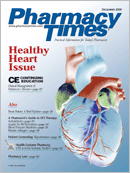Publication
Article
Pharmacy Times
Baraclude (entecavir)
Author(s):
The FDA has approved Baraclude(entecavir) from Bristol-MyersSquibb for the treatment ofadults with hepatitis B virus (HBV).The drug is indicated for adults withactive viral replication and either persistentlyelevated aminotransferases orhistologically active disease. Baracludeis available as 0.5-and 1-mg tabletsand as a 0.05-mg/mL oral solution.Baraclude is approved for use inpatients 16 years and older.1
Pharmacology
Baraclude is a guanosine nucleosideanalogue that is active against HBVpolymerase. When phosphorylated toits active form, Baraclude competeswith the natural substrate to inhibit(1) base priming; (2) reverse transcriptionof the negative strand of messengerRNA; and (3) synthesis of the positivestrand of HBV. This action resultsin the successful inhibition of all 3activities of the HBV polymerase.1
Clinical Trials
Baraclude was evaluated for safetyand efficacy in 3 phase 3 clinical trials.Each trial was active-controlled andinvolved patients aged 16 years or olderwith chronic hepatitis B infection, evidenceof viral replication, alanineaminotransferase levels elevated at least1.3 times above normal, and chronicinflammation as proven by liver biopsy.1
Two of the 3 studies evaluatedpatients with compensated liver diseasewho had not been treated previouslywith nucleoside agents. StudyA1463022 and study A1463027 weremultinational, randomized, doubleblindstudies that compared Baraclude0.5 mg daily with lamivudine 100 mgonce daily for 52 weeks. At 48 weeks,67% of the A1463022 patients and90% of the A1463027 patients displayeda viral load of <300 copies/mL.Resistance to Baraclude was not foundin either trial.1,2
The third clinical trial evaluated theuse of Baraclude in patients previouslytreated with lamivudine. StudyA1463026 was a multinational, randomized,double-blind study of Baraclude1 mg daily or lamivudine 100mg daily. At 48 weeks, 19% of the Baracludepatients achieved an HBV viralload of <300 copies/mL. Only 1% ofthe lamivudine patients achieved thisvalue. In this study, genotypic analysisfound resistance to Baraclude.1,2
Safety
Nucleoside analogues, both aloneand in conjunction with antiretrovirals,have been associated with lacticacidosis and severe hepatomegaly withsteatosis. Lactic acidosis often presentsas fatigue, unusual muscle pain, difficultybreathing, severe stomach painwith nausea and vomiting, coldness,dizziness, or irregular heartbeat. Signsof hepatotoxicity may include jaundice,dark urine, pale bowel movements,anorexia, nausea, or lowerstomach pain. Patients should be educatedto contact a health care professionalimmediately if they develop anysigns of either complication.
Discontinuing Baraclude may beassociated with a severe exacerbationof HBV. Hepatic function should befollowed closely for several months inpatients who stop taking the drug.Patients with a history of hypersensitivityto Baraclude should not take it.
Baraclude was not found to bealtered or metabolizedby thecytochrome P-450 (CYP450)enzyme system.Concomitantadministrationof Baraclude withmedications that alter renal functionor compete for active tubular secretionmay result in a need for a dosingadjustment.
Baraclude is in pregnancy category C.It should not be used in women who arelactating, because its safety in breast-feedinghas not been determined.1
The most commonly reported adverseeffects included headache, fatigue,dizziness, and nausea. Additionaladverse effects included diarrhea,indigestion, vomiting, and insomnia.1,3
Outlook
The usual starting dose for nucleoside-naïve patients is 0.5 mg daily. Patientswho have failed lamivudinemay require 1 mg daily.2 Baraclude iscleared renally; patients with a creatinineclearance of <50 mL/min will requirea lower dose of Baraclude.When the drug is administered to elderlypatients, dosing should be basedon renal function instead of age. Nodose adjustment is necessary in hepaticimpairment. Baraclude has notbeen studied in liver transplantpatients. The drug should be takendaily on an empty stomach, 2 hoursbefore or after a meal.1
Dr. Holmberg is a pharmacist with PhoenixChildren's Hospital, Phoenix, Ariz.
For a list of references, send astamped, self-addressed envelope to:References Department, Attn. A. Stahl,Pharmacy Times, 241 Forsgate Drive,Jamesburg, NJ 08831; or send an e-mailrequest to: astahl@ascendmedia.com.







